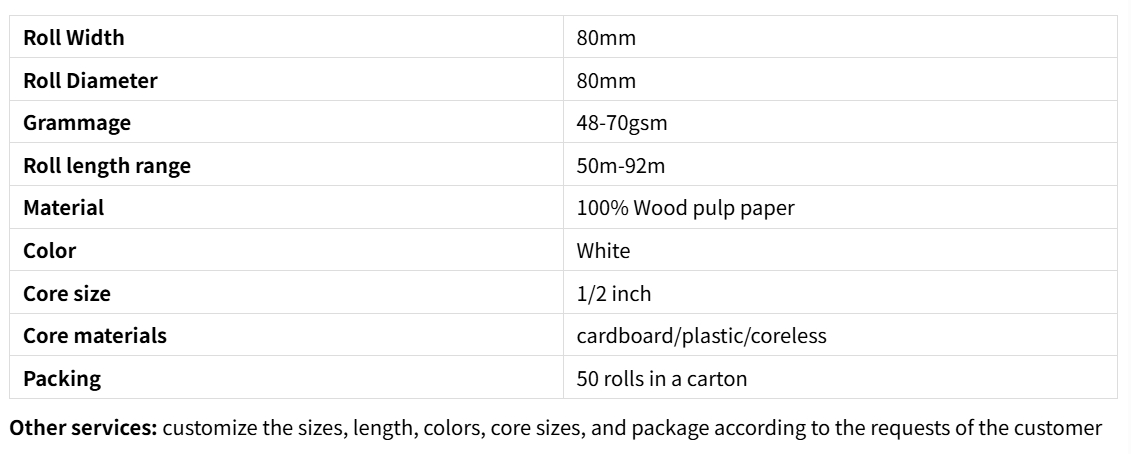

| Availability: | |
|---|---|
| Quantity: | |








The BPA-Free Thermal Paper Roll 80x80mm is a premium printing solution designed for businesses prioritizing safety, quality, and environmental responsibility. As a Bisphenol A free Thermal Paper, it eliminates the risk of harmful chemical exposure, making it ideal for medical, food-related, and retail applications. Crafted from 100% Wood pulp paper with a high-contrast heat-sensitive coating, this Thermal Paper Roll 3 1/8 (equivalent to 80mm) delivers sharp, long-lasting prints that resist fading, smudging, and water damage. Compatible with most standard thermal printers, it’s a versatile choice for industries requiring reliable documentation—from medical records to retail receipts. Each roll has a length range of 50m-92m, packed in cartons of 50 rolls, ensuring ample supply for high-volume use.
Our BPA-Free Thermal Paper Roll features a multi-layered design that balances strength and flexibility. The base layer provides a smooth, even surface for crisp prints, while the middle layer adds structural integrity to prevent tearing. The top layer is a specially formulated BPA-Free Heat-Sensitive Coating that reacts quickly to thermal print heads, producing high-contrast text and images. This coating ensures readability even for small fonts and barcodes, making it ideal for detailed documentation like medical reports and shipping labels.
With a grammage range of 48-70gsm, the paper is sturdy enough to withstand handling and storage without tearing, yet flexible enough to feed smoothly through printers. The edges are precisely cut to prevent jams and ensure consistent feeding, reducing downtime for businesses relying on continuous printing. The roll’s dimensions (80mm width, 80mm diameter) and 1/2-inch core (cardboard, plastic, or coreless) make it compatible with a wide range of printer models, including POS systems, desktop printers, and mobile thermal printers.
As an Eco-friendly thermal paper, it eliminates the need for ink or toner, reducing chemical pollution and waste. Most materials are recyclable, aligning with sustainable business practices and global environmental goals. The prints are durable, minimizing the need for reprints and further reducing waste. Additionally, the paper is manufactured using energy-efficient processes, lowering its carbon footprint.
Safety First: Being Bisphenol A free Thermal Paper, it’s safe for food-related applications (such as grocery receipts and food labels) and medical settings. No harmful chemicals leach into products or surroundings, protecting both customers and staff.
High Contrast & Durability: The advanced coating delivers sharp, high-contrast prints that resist fading, smudging, and water damage—ideal for long-term record-keeping. Under normal storage conditions, prints remain legible for up to 5 years.
Energy & Cost Efficiency: Ink-free printing saves time on cartridge/toner replacements and reduces operational costs by up to 40%. The fast heat transfer ensures quick printing (up to 200mm per second), boosting productivity.
Versatile Compatibility: Designed to work with most standard thermal printers, this 80x80mm Thermal Paper Roll integrates seamlessly into retail, healthcare, hospitality, and transportation systems. It requires no special software or hardware adjustments, making it easy to adopt.
We offer flexible customization for our BPA-Free Thermal Paper Roll 80x80mm. Adjust size (width, length, diameter), color (standard white or custom colors), core material, and packaging to match your requirements. Whether you need a specific roll length (50m-92m) or custom packaging (e.g., individual roll wrapping for hygiene), our team can accommodate your needs. For businesses with unique branding, we also support custom printing of logos or text—contact our customer support for a personalized quote.
The BPA-Free Thermal Paper Roll 80x80mm combines safety, durability, and eco-friendliness—making it the ideal choice for businesses that refuse to compromise on quality. Invest in a printing solution that protects your customers, your team, and the planet.

